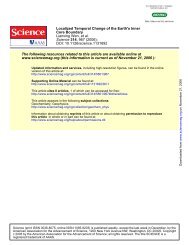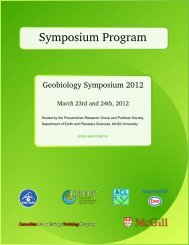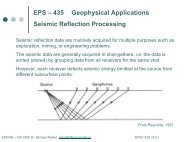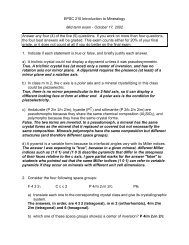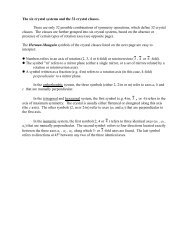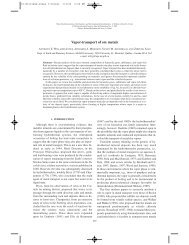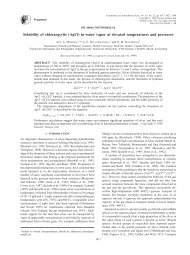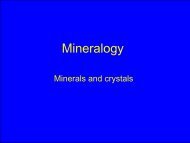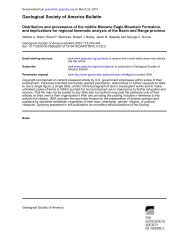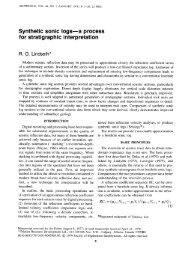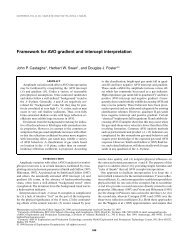05 Classification of.. - Department of Earth and Planetary Sciences
05 Classification of.. - Department of Earth and Planetary Sciences
05 Classification of.. - Department of Earth and Planetary Sciences
You also want an ePaper? Increase the reach of your titles
YUMPU automatically turns print PDFs into web optimized ePapers that Google loves.
110<br />
<strong>Classification</strong> <strong>of</strong> Meteorites<br />
Figure 21 Photomicrographs in transmitted light with crossed polars (a, b, d) <strong>and</strong> reflected light (c) <strong>of</strong> ureilites<br />
Kenna (a), LEW88774 (b), ALH83014 (c), <strong>and</strong> Hughes 009 (d). (a) Kenna contains coarse-grained olivine <strong>and</strong><br />
pigeonite in equilibrated (note abundant triple junctions), foliated texture. Abundant black material along olivine<br />
grain boundaries <strong>and</strong> in crosscutting veins consists <strong>of</strong> fine-grained graphite <strong>and</strong> reduction rims/veins characteristic<br />
<strong>of</strong> ureilites.(b) LEW88774 has large oikocryst <strong>of</strong> low-Ca pyroxene (now orthopyroxene with augite exsolution<br />
lamellae, oriented diagonally upper right to lower left) enclosing irregularly shaped, embayed <strong>and</strong> corroded<br />
grains <strong>of</strong> augite (blue) which are in optical continuity with one another (as can be seen in the similar orientation<br />
<strong>of</strong> shock-produced twins) <strong>and</strong> appear to be remnants <strong>of</strong> once single crystals <strong>of</strong> primary augite which reacted<br />
with the liquid from which the oikocryst crystallized. (c) In ALH83014, ureilite with very low shock level,<br />
graphite grains occur along grain boundaries <strong>and</strong> within olivine grains as large, euhedral crystals rather than<br />
the fine-grained masses seen in most ureilites. (d) The olivine–augite–orthopyroxene ureilite Hughes 009<br />
shows highly equilibrated texture typical <strong>of</strong> olivine–pigeonite ureilites. Olivine contains magmatic inclusions<br />
(center <strong>of</strong> crystal, bottom).<br />
(1979, 1997) in his layered crust model <strong>of</strong> the<br />
HED parent body.<br />
Howardites. These are lithified regolith from<br />
the surface <strong>of</strong> the HED parent body, as indicated<br />
by high contents <strong>of</strong> solar-wind-implanted noble<br />
gases in their fine-grained, clastic, impactproduced<br />
matrices (e.g., Suess et al., 1964)<br />
(Figure 22(a)). They are polymict breccias<br />
<strong>and</strong> consist mostly <strong>of</strong> eucritic <strong>and</strong> diogenitic<br />
material with .10 vol.% <strong>of</strong> orthopyroxene as well<br />
as some olivine. In addition, they contain<br />
abundant impact-melt clasts <strong>and</strong> breccia<br />
fragments, <strong>and</strong> occasionally carbonaceous<br />
chondrite xenoliths (e.g., Metzler et al., 1995;<br />
Pun et al., 1998).<br />
Eucrites. These are pyroxene–plagioclase<br />
basalts <strong>and</strong> are subdivided into three major<br />
subclasses: the noncumulate eucrites (basaltic<br />
eucrites), the cumulate eucrites, <strong>and</strong> the polymict<br />
eucrites.<br />
Polymict eucrites (Figure 22(b)) are polymict<br />
breccias consisting mostly <strong>of</strong> eucritic material, but<br />
they also contain ,10 vol.% <strong>of</strong> a diogenitic<br />
component in the form <strong>of</strong> orthopyroxene.<br />
Noncumulate eucrites originally formed<br />
as quickly cooled surface lava flows (unequilibrated<br />
noncumulate eucrites), but most were<br />
subsequently metamorphosed (metamorphosed<br />
noncumulate eucrites). Unequilibrated noncumulate<br />
eucrites, also referred to as the unmetamorphosed<br />
or least-metamorphosed noncumulate<br />
eucrites or Pasamonte-type eucrites, are surface<br />
lava flows (Figure 22(c)) that cooled quickly<br />
(Walker et al., 1978). As a result <strong>of</strong> their fast<br />
cooling, their pyroxenes (pigeonite <strong>of</strong> Mg#<br />
,70–20) are zoned, <strong>and</strong> exsolution lamellae are<br />
only visible by TEM. These rocks have experienced<br />
only minor metamorphism (e.g., Takeda<br />
<strong>and</strong> Graham, 1991).<br />
Metamorphosed (equilibrated) noncumulate<br />
eucrites are also collectively referred to as the<br />
ordinary eucrites. They include the Juvinas type<br />
(main group) <strong>and</strong> the Stannern <strong>and</strong> Nuevo Laredo<br />
types. They are unbrecciated or monomictbrecciated,<br />
metamorphosed basalts (Figure 22(d))<br />
<strong>and</strong> contain homogeneous low-calcium pigeonite<br />
(Mg# ,42–30) with fine exsolution lamellae<br />
<strong>of</strong> high-calcium pyroxene. The high abundance



